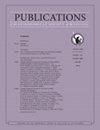不再不可能自感双星 KIC 8145411 是一个三重星
IF 7.7
3区 物理与天体物理
Q2 ASTRONOMY & ASTROPHYSICS
Publications of the Astronomical Society of the Pacific
Pub Date : 2024-07-21
DOI:10.1088/1538-3873/ad5ebd
引用次数: 0
摘要
开普勒任务的数据发现了五个自感双星(SLB)。其中一个系统是KIC 8145411,据报道该系统包含一个质量极低(ELM;0.2 M⊙)的白矮星(WD),与一个太阳型伴星在456天的轨道上运行。这个系统被称为 "不可能的",因为根据演化模型的预测,0.2 M⊙白矮星只能在紧密的轨道(Porb ≲天)上被发现。在这项工作中,我们证明了KIC 8145411实际上是一个分级三重系统:它包含一个绕太阳型恒星运行的WD,与另一颗太阳型恒星相距700 au。开普勒光变曲线无法分辨出这颗宽伴星,盖亚DR3也只能勉强分辨出它,而高分辨率成像技术则毫无疑问地分辨出了它。我们的研究表明,这个三级伴星的存在混淆了之前对 WD 质量的测量,原因有二:它稀释了自透镜脉冲的振幅,而且由于线混合,它降低了 WD 伴星的视径向速度(RV)变异振幅。通过使用两颗发光恒星模型联合拟合该系统的光曲线、RV和多波段光度测量,我们得到了修正后的WD质量为(0.53 ± 0.01)M⊙。这两颗发光恒星都接近其主序演化的末期。因此这个WD并不是一个ELM WD,而且这个系统的形成历史也没有受到之前提出的挑战。与其他SLB和最近从盖亚数据中发现的天体测量WD双星群相似,KIC 8145411的参数也符合通过稳定和不稳定质量转移(MT)形成的标准预期。该系统的特性最好理解为来自 AGB 供体恒星的不稳定质量转移的结果。本文章由计算机程序翻译,如有差异,请以英文原文为准。
No Longer Impossible: The Self-lensing Binary KIC 8145411 is a Triple
Five self-lensing binaries (SLBs) have been discovered with data from the Kepler mission. One of these systems is KIC 8145411, which was reported to host an extremely low mass (ELM; 0.2 M⊙) white dwarf (WD) in a 456 days orbit with a solar-type companion. The system has been dubbed "impossible," because evolutionary models predict that ∼0.2 M⊙ WDs should only be found in tight orbits (Porb ≲ days). In this work, we show that KIC 8145411 is in fact a hierarchical triple system: it contains a WD orbiting a solar-type star, with another solar-type star ∼700 au away. The wide companion was unresolved in the Kepler light curves, was just barely resolved in Gaia DR3, and is resolved beyond any doubt by high-resolution imaging. We show that the presence of this tertiary confounded previous mass measurements of the WD for two reason: it dilutes the amplitude of the self-lensing pulses, and it reduces the apparent radial velocity (RV) variability amplitude of the WD's companion due to line blending. By jointly fitting the system's light curves, RVs, and multi-band photometry using a model with two luminous stars, we obtain a revised WD mass of (0.53 ± 0.01)M⊙. Both luminous stars are near the end of their main-sequence evolution. The WD is thus not an ELM WD, and the system does not suffer the previously proposed challenges to its formation history. Similar to the other SLBs and the population of astrometric WD binaries recently identified from Gaia data, KIC 8145411 has parameters in tension with standard expectations for formation through both stable and unstable mass transfer (MT). The system's properties are likely best understood as a result of unstable MT from an AGB star donor.
求助全文
通过发布文献求助,成功后即可免费获取论文全文。
去求助
来源期刊
CiteScore
6.70
自引率
5.70%
发文量
103
审稿时长
4-8 weeks
期刊介绍:
The Publications of the Astronomical Society of the Pacific (PASP), the technical journal of the Astronomical Society of the Pacific (ASP), has been published regularly since 1889, and is an integral part of the ASP''s mission to advance the science of astronomy and disseminate astronomical information. The journal provides an outlet for astronomical results of a scientific nature and serves to keep readers in touch with current astronomical research. It contains refereed research and instrumentation articles, invited and contributed reviews, tutorials, and dissertation summaries.

 求助内容:
求助内容: 应助结果提醒方式:
应助结果提醒方式:


